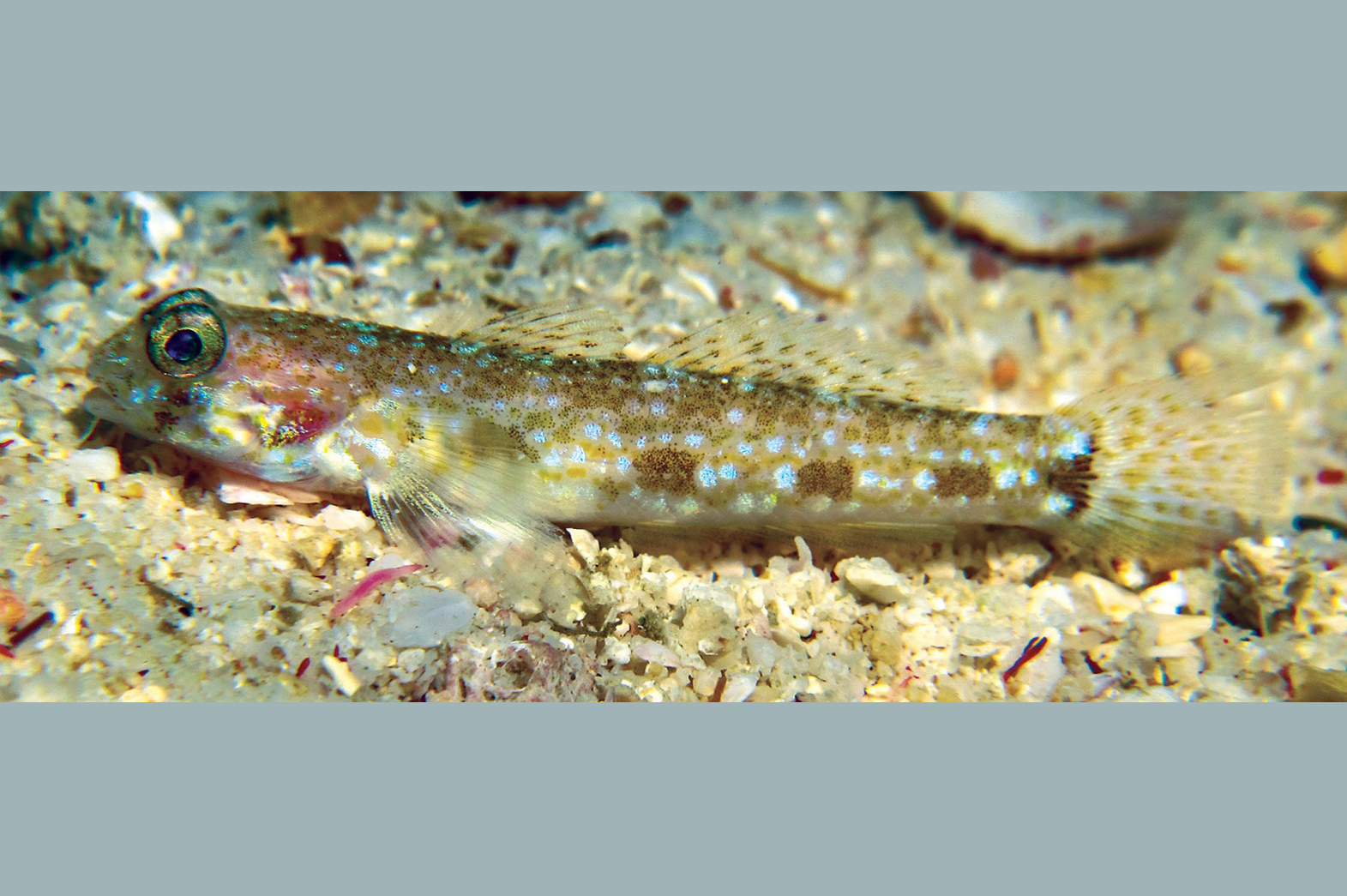Murdy’s Sandgoby, Istigobius murdyi Hoese & Erdmann 2018

Murdy's Sandgoby, Istigobius murdyi, from Misool, Raja Ampat Islands, West Papua, Indonesia, depth 70 m - image of live holotype. Source: Mark V. Erdmann, Fig. 1, in Hoese & Erdmann (2018) Journal of the Ocean Science Foundation 30: 70-77. License: CC by Attribution
Summary:
A small deepwater sandgoby with a distinctive vertical black bar below the eye, four golden-brown rectangular spots along the midside, a dark spot on the caudal peduncle with upper and lower extensions, and small bluish-white spots scattered on the head and body. The pattern of pattern of blue and gold spots camouflages the goby on sandy/rubble bottoms.
Cite this page as:
Bray, D.J. 2018, Istigobius murdyi in Fishes of Australia, accessed 20 Apr 2024, https://fishesofaustralia.net.au/Home/species/5438
Murdy’s Sandgoby, Istigobius murdyi Hoese & Erdmann 2018
More Info
|
Distribution |
North West Shelf, south-east of Rowley Shoals, Western Australia, and the Raja Ampat Islands, West Papua Province, Indonesia. Inhabits open, sandy areas on gentle reef slopes with mixed sand and small coral rubble substrates, exposed to frequent currents and coldwater upwelling (in Indonesia). The Australian specimens were collected just off a reef edge in a depth of about 100 m. |
|
Features |
Dorsal fin VI + I, 10; Anal fin I, 9; Pectoral fin 16-18; Longitudinal-scale count (scales from upper pectoral-fin base insertion to end of caudal peduncle) 24-25, with 2 scale rows above pectoral-fin base, 3 scale rows on base of caudal fin; Midline predorsal-scale count 7-8; Transverse-scale count (TRB), 8; Caudal fin (segmented rays) 9/8; Caudal fin (branched rays) 7/6-7. Head slightly depressed, length 27.9–29.7% SL; head depth at preopercular margin 15.2–17.4% SL. |
|
Colour |
Head and body light brown. Head with a dark-brown to black bar (narrower than pupil diameter) extending from below middle of eye to posterior end of jaws; sides of head with scattered small bluish-white spots and larger irregularly shaped yellow patches. Body with four dark-brown rectangular spots along midside, first below middle of first dorsal fin; second below anterior part of second dorsal fin, third below middle of second dorsal fin; fourth on middle of caudal peduncle; a dark brown spot at posterior end of caudal peduncle, with curved thin upward and downward projections, or with an isolated spot above and a similar spot below behind midline spot. First dorsal fin with two rows of small dark-brown elongate spots; second dorsal fin with 3 to 5 oblique rows of similar spots; anal fin pale brown to whitish; caudal fin with larger spots in 4–6 wavy rows; pectoral-fin base with a prominent short white stripe, base of fin with a small black spot dorsally, rest of fin translucent. |
|
Remarks |
This species is the first sandgoby to be collected from mesophotic reefs. The Australian specimens from the North West Shelf were collected in a sled from depths of 80-109 m. Murdy's Sandgoby is by far the smallest known species in the genus Istigobius. |
|
Similar Species |
Differs from all other species in the genus in having the anterior nostril much closer to the upper lip than to the eye and the distance from the upper lip to the anterior nostril subequal to the distance between the anterior and posterior nostrils (vs. about halfway between the eye and the upper lip and closer to or equal to the distance between the anterior and posterior nostrils. Murdy’s Sandgoby is most similar to Istigobius spence in the anterior extent of the prepelvic scales, reaching to below the posterior margin of the eye or just behind the eye. In I. murdyi, the row of predorsal scales above the operculum are cycloid vs. ctenoid in I. spence. The sensory papillae appear to be more reduced in the new species than in I. spence. I. murdyi also differs from I. spence in having a prominent black bar below the eye (vs. a horizontal dark bar), rectangular blotches on the midside (vs. single or paired spots), and the suborbital depth about half the eye (vs. about equal). I. spence is widely distributed from east Africa to Australia, usually inhabiting coastal and near shore silty reefs on the Great Barrier Reef in depths of 1–12 m (Hoese & Erdmann 2018). |
|
Etymology |
The species is named for Ed Murdy, who pioneered research on the genus Istigobius. |
|
Species Citation |
Isitgobius murdyi Hoese & Erdmann 2018, J. Ocean Sci. Found. 30: 76, Figs 106. Type locality: Indonesia, West Papua, Raja Ampat Islands, Misool, 2.2199°S, 130.5638°E, 69–70 m. |
|
Author |
Bray, D.J. 2018 |
Murdy’s Sandgoby, Istigobius murdyi Hoese & Erdmann 2018
References
Hoese, D.F. & Erdmann, M.V. 2018. Description of a new species of Istigobius (Teleostei: Gobiidae) from Australia and Indonesia. Journal of the Ocean Science Foundation 30: 70–77. doi: http://dx.doi.org/10.5281/zenodo.1291469 Open access



